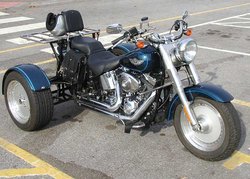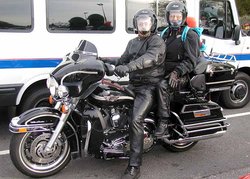Harley-Davidson
|
|
Harley_Davidson_2003.jpg
The Harley-Davidson Motor Company Template:Nyse is a manufacturer of motorcycles based in Milwaukee, Wisconsin. Harley-Davidson motorcycles are distinctive in design and attract a loyal following for their history and design. The company, which is the only remaining American mass-producer of motorcycles, has an emphasis on heavy bikes designed for cruising. The motorcycles are known for their distinctive exhaust noise. Bikers who are not fans contend that the bikes are badly engineered, under-powered and under-performing, and have poor handling and suspension, mainly as a result of their American pedigree (designed for long, low-speed cruising on flat, straight roads.)
The company supplies many domestic police forces with their motorcycle fleets. Harley's are especially noted for the tradition of heavy customization that gave rise to the chopper-style of motorcycle.
| Contents |
History
Founding of the Motor Company
The Harley-Davidson enterprise started less than auspiciously in Milwaukee in 1901 when William Harley, 21 and Arthur Davidson, 20, built a prototype motorized bicycle. It was built in the Davidson garage, which measured only 10 by 15 ft (3 by 5 m). Once their prototype was functional, they were joined by Davidson's two brothers William and Walter.
1907_Harley_Davidson.jpg
In their first two years, they only produced 3 motorcycles.
The Harley-Davidson Motor Company was officially founded on August 28, 1903, and officially started production. They had made some big changes from the early prototypes, including a redesigned frame. Even so, the 1903 production was only 3 bikes.
In 1906 they built their first factory on Juneau Avenue, which is still the location of the company headquarters. The original garage was accidently destroyed by contractors working on the new building. They had been ramping production up gradually, and with the new facilities were able to produce 150 motorcycles in 1907, an important year in the life of the fledgling company. They began selling their motorcycles to police fleets, a tradition that continues today.
The early bikes had a single-piston engine. In 1909 a 45-degree V-Twin engine was introduced. The first V-Twin was not the powerhouse that it is today. It displaced only 49.6 cubic inches (810 cm³) and produced only 7 horsepower (5 kW) which was double the power of the first bikes. The top speed was 60 mph (97 km/h), a good speed for those days. Production was 1,149 motorcycles.
The success of the company had begun to attract attention, and Harley-Davidson had over 150 competitors by 1911.
By 1913 the original factory, which measured only 28 by 80 ft (9 by 24 m), had been expanded to a roomy 297,110 ft³ (28,000 m³). Despite the harsh competition, Harley-Davidson was already pulling ahead of the pack, completely dominating motorcycle racing. Production had swelled to 12,904 machines.
World War I Era
In 1917, the United States was drawn into World War I. The military demanded motorcycles for the war effort. Harleys had already been used by the military in border skirmishes with Pancho Villa, but World War I was the first time the motorcycle had been broadly adopted for combat service. The company had consolidated its position as the motorcycle of choice for police forces. Harley-Davidson provided over 20,000 machines to the military forces during World War I.
By 1920, Harley-Davidson was the largest motorcycle manufacturer in the world. Their motorcycles were sold by dealers in 67 countries. Production was 28,189 machines.
In 1921, a milestone was reached in motorcycle racing. A Harley-Davidson machine was the very first to win a race at an average speed of over 100 mph (160 km/h).
During the 1920s, several improvements were put in place, such as a new 74 cubic inch (1.2 L) V-Twin, introduced in 1922, and the gas tank we still see today, called a "Teardrop" tank, in 1925. A front brake was added in 1928.
World War II Era
One of only two American cycle manufacturers to survive the Great Depression, Harley-Davidson again produced large numbers of motorcycles for the army in World War II and resumed civilian production afterwards, producing a range of large V-twin motorcycles that were successful both on racetracks and for private buyers.
Modern Era
Fxstc1998.jpg
By the 1970s, however, the Harley Davidson Company had ceased to be an innovator in the motorcycle industry, and the design had remained basically unchanged for many years. The bikes were expensive and far inferior in performance, handling, and quality to Japanese motorcycles. In 1969, American Machine and Foundry AMF bought the company and streamlined production by slashing the workforce. This tactic resulted in a labor strike and an even lower quality of bikes. Sales declined, quality plummeted, and the company almost went bankrupt. The venerable name of "Harley Davidson" was mocked as "Hardly Able", and the nickname "hog" was both affectionate and pejorative. In 1981, AMF sold the company back to a group of thirteen investors led by Vaugh Beals and Willie G Davidson. They introduced the "Sturgis" model boasting a dual belt drive. Inventory was strictly controled using the MAN (materials as needed) system. As a result, quality and buyers slowly returned. The motor company increased sales and gradually captured an ever increasing zealous following of loyal customers. It was not until 1990 with the introduction of the "Fat Boy", that Harley would commerate the distinction of once again being the sales leader in the heavyweight (over 750cc) market. There was a controversy that the Fat Boy model was allegedly inspired by the name of the bombs dropped on Nagasaki and Heroshima. The company vehemently denies this and claims it is coincidence. Harley maintains dominance in sales to date.
Rather than trying to match the Japanese at their own game, this new management deliberately exploited the "retro" appeal of the machines, building motorcycles that deliberately aped the look and feel of their earlier machines and the subsequent customizations of owners of that era. Quality was better, and technical improvements have been made, but these goals were never achieved at the cost of substantially modifying the design of the machine except by gradual degrees.
Even a brand new Harley therefore is in some respects a classic waiting to happen. Probably for this reason, as well as their general collectibility, Harley-Davidson motorcycles hold their resale value very well compared to other vehicles. A well maintained vehicle might never drop in value at all, although regular maintenance and customization are expected.
Similarly, the company now makes more money selling licensed merchandise featuring the Harley-Davidson logo than selling motorcycles.
Today, Harley-Davidson is considered an example of an American company that turned itself around from the brink of bankruptcy and back to profitability.
In 1997, Ford Motor Company added a Harley-Davidson edition to the Ford F-Series Super Duty line, complete with the Harley-Davidson logo. Ford will add a 2006 F-150 Harley-Davidson this fall.
In 1998, Harley-Davidson acquired long time partner Buell Motorcycle Company. Buell motorcycles were first built in 1993 by a partnership between Harley-Davidson and former Harley Engineer Eric Buell. Buell started with a stock Sportster engine, highly modified it and bolted it into a frame of his own design. Today, Buell motorcyles are on the cutting edge of street bike technology. They typically employ radical frame designs and state of the art suspension systems that, along with the high output Sportster engine, culminate in a powerful, nimble and atypical alernative to the Japanese sport bikes.
The Harley-Davidson V-twin engine
The classic Harley-Davidson engines are two-cylinder, V-twin engines with the pistons placed at a 45 degree angle. The engine design, which is covered under several United States patents, produces the unique, signature throbbing sound of the Harley-Davidson power plant.
The crankshaft has a single pin, and both pistons are connected to this pin through their connecting rods. This design causes the pistons not to fire at even intervals.
On the V-twin the first piston fires. Then the other piston fires at 315 degrees into the stroke. There is a 405-degree gap until ... the first piston fires again. This give the Harley-Davidson V-twin its unique "potato-potato" sound.
Harley Davidson Co endeavoured to file as a registered trade mark the distinctive sound of a Harley Davidson motorcycle engine. On 1 February 1994, the company filed an application for a sound trade mark: "The mark consists of the exhaust sound of applicant's motorcycles, produced by V-twin, common crankpin motorcycle engines when the goods are in use". Nine of Harley Davidson's competitors filed oppositions against the application, arguing that cruiser-style motorcycles of various brands use a single-crankpin V-twin engine which produces the same sound. After six years of litigation, with no end in sight, Harley Davidson withdrew their application in early 2000.
The early Harleys had experimental motors, followed by:
- The Flathead, 1929-1974, 45 cubic inches (0.7 L)
- Knucklehead, 1909-47, 60 and 74 cubic inches (1.0 and 1.2 L)
- Panhead, 1948-65, 60 and 74 cubic inches (1.0 and 1.2 L)
- Shovelhead, 1966-85, 74 cubic inches (1.2 L) and 80 cubic inches since late 1978
- Evolution (aka "Evo" and "Blockhead"), 1984-99, 80 cubic inches (1.3 L)
- Twin Cam (aka "Fathead") 1999-present, 88 cubic inches (1.4 L)
- Ironhead, 1967-1984, 883, then 1000 cc
- Sportster (with a smaller version of the Evo engine), 1985-present, 883 and 1200 cc
- Revolution, 2002-present, 69 cubic inches (1.1 L), Used exclusively in the V-Rod
Models
Harley models initials can be extremely long, such as FLHRCI, and some combinations don't make sense. In general, though, the first letter is F (Big Twin) or X (Sportster).
Other intials include: B (Belt Drive), C (Classic, or sometimes Custom), D (Dyna Glide), DG (Disk Glide), E Electric-start), F (Fatboy), FI (Fuel-Injection), H (High-compression), L (Hydraglide big forks), LR (Low Rider), P (Police), S (Springer), SB (Single Belt final drive), ST (Softail), T (Touring), WG (Wide Glide)
The 100th Anniversary
In 2003, Harley-Davidson celebrated its 100th birthday. On Labor day weekend the city of Milwaukee (the home of HD) hosted the biggest Harley-Davidson event, if not the largest motorcycle event, in history.
Popular events, frequented by Harley Riders
- Sturgis Motorcycle Rally - Held at the beginning of August each year in Sturgis, South Dakota, 514,951 attended in 2004.
- Laconia Motorcycle Week - Held since the first Loudon classic race started 1923. Located in Laconia, New Hampshire
- Daytona Beach Bike Week - Held since 1937 in Daytona Beach, Florida.
- Republic of Texas Biker Rally - A popular event in Austin, Texas held every June.
- Myrtle Beach Bike Week - A spring and fall rally in Myrtle Beach, South Carolina Click on link here (http://www.myrtlebeachbikeweek.com).
Harley Owners Group
Harley_Rider.JPG
Harley-Davidson established the Harley Owners Group (HOG)[1] (http://www.hog.com) in 1983 in response to a growing desire by Harley riders for an organized way to share their passion and show their pride. By 1985, 49 local chapters had sprouted around the country, with a total membership of 60,000.
Rapid growth continued into the 1990s, and in 1991 HOG officially went international, with the first official European HOG Rally in Cheltenham, England. Worldwide membership numbered 151,600, with 685 local chapters.
As the '90s continued, HOG spread into Asia, including new chapters in Singapore and Kuala Lumpur, Malaysia. By 1999, worldwide membership had hit the half-million mark, and the number of local chapters totaled 1,157. Today, more than 800,000 members make HOG the largest factory-sponsored motorcycle organization in the world, and it shows no signs of slowing down.
See also
Harley Davidson motorcycles has long been associated with the sub-cultures of the:
External links
- Official company website (http://www.harley-davidson.com)
- The First Motorcycle (http://stroked.virtualave.net/page1.html)de:Harley-Davidson
es:Harley-Davidson fi:Harley-Davidson fr:Harley-Davidson nl:Harley-Davidson ja:ハーレーダビッドソン sv:Harley-Davidson



